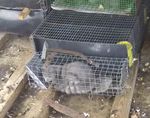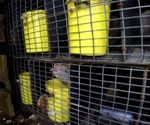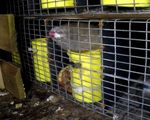Mink transport inspection (PL) 12.04.2018 - Bont voor Dieren
←
→
Page content transcription
If your browser does not render page correctly, please read the page content below
Mink transport inspection (PL)
12.04.2018
Date and place of inspection
- 12.04.2018, 07:40.
- A2 highway south of Poznan, Gołuski toll gates, direction Warsaw.
Route
- Meijel (NL) -> 3 farms in Western Poland
- Departure: 11.04.2018
- Arrival at first destination: 12.04.2018, early morning.
- In the moment of inspection, two destinations remaining.
Transport conditions
- Transported animals: female minks to be used for breeding (based on info from driver).
- Truck partially unloaded in first destination. Two destinations left. About half of the truck still loaded
with cages.
- Minks carried in crates with compartments, each in separate compartment. Compartments are small,
but minks are able to turn around and lie down. Each compartment has a bucket for feed. Most are
empty during inspection. In many crates there are leftovers of apple pieces.
- Crates are arranged in 4 rows, 8 crates high in 3 rows, 7 crates high in 1 row. Between row 2 and 3,
along the middle of the truck, pallets are stacked vertically (on their sides). On the floor of the vehicle,
wooden bars are placed along its length, and bottom crates rest on them. Similar, but smaller wooden
bars are placed between crates in each column. The bars are of different sizes and not secured with
anything. As a result, crates (especially in one row) are placed unevenly, forcing animals to travel on a
slanted/sloping floor. The crates are not secured with anything preventing the movement forward or
backward. See Fig. 1.
- On sides, there are 3 wooden planks along the truck securing the crates, on the level of crate 4, 6 and
8 (counting from the bottom). The construction raises serious concerns as to its stability. See Fig. 1.
-
1Figure 1: Arrangement of crates, cages in row 3 arranged at an angle, pallets blocking access,
mink transported in an individual cage (in front of row 2), crates not secured.
- Due to arrangement of the crates, there is no access whatsoever to animals in rows 2 and 3, except
minks that are at the back of the crates (looking from the front of the vehicle). See Fig. 1.
- Crates are made of metal mesh, some of them have sides secured with plastic. Between crates
(horizontally) there are layers of thin paper/plastic or cardboard, probably to prevent contamination
of minks from lower cages with excrements of minks from higher crates. The layers are sometimes
bitten off or too small to prevent the leaking of excrements. They also do not provide comfort or
support to the minks’ feet. See Fig. 2.
Figure 2: Metal mesh crates with paper in between
- One mink is found loose on pallets between rows 2 and 3. One is seen on top of row 3, behind the
cabin. One mink is carried in a separate tiny crate the size of 1 compartment. The driver explains that
it must have got loose and was caught in this extra crate. See Fig. 3.
2Figure 3: Minks who escaped
- The floor of the vehicle is dirty, there is a strong bad smell. The cages are dirty as well. See Fig. 4.
Figure 4: Dirty cages /floors
3-
- Important note: several animals displayed severe stereotypies and stress signals, like rolling their
tongues, biting in the food buckets, escape attempts and continuously walking back and forth
(documented on video footage). See Fig. 5.
Figure 5: Minks displaying severe stereotypies and stress signals
Violations/concerns
- Unnecessary suffering of animals by forcing them to endure transport on non-horizontal and wire
floor (art. 3, in particular 3c; Annex I, Chapter II, art. 1.1.a)
- Lack of access to all animals for inspection or aid (art. 3.f; Annex I, Chapter II, art. 1.1.f)
- Animals breaking loose – containers not proper (Annex I, Chapter II, art. 1.1.d)
- Lack of written instructions concerning feeding, watering and care (Annex I, Chapter II, 1.3.b; Annex I,
Chapter V, art. 2.3)
- Instability of containers (Annex I, Chapter II, art. 5.2; Annex I, Chapter III, art. 1.7.b)
- The flooring surface did not fully minimize leakage of urine or faeces (Annex I, Chapter II, 1.1.h)
Vehicle information
- Cabin: blue DAF, with white drawing of a mink on front and door, and name FUTREX in white under
windscreen. See Fig. 6. The company owns several trucks, also used to transport feed, but all cabins
are in the same colour and with the same logos.
- Semitrailer: green mesh curtains with silver lining (like for poultry), tailboard white with old Dutch
inscriptions.
- Licence plates cabin: (PL) ZGL 44010
- Licence plates trailer: (PL) ZGL 90HP
- Approval certificate No. PL 32042812, limited to minks, valid until 10.06.2021
4Figure 6. Futrex mink transport arriving at place of inspection
Transporter information:
- Name: Joni Mink Van Ansem sp.j.
- Address: Żdżary 1, 72-100 Goleniów
- Transporter authorization: Type 2, No. 32042821, limited to minks, valid until 09.04.2020
- Owns 3 semitrailers registered for long-distance transport of minks
- Cooperates with 43 farms in Poland. 13 of them belong to Van Ansem family.
- Van Ansem is one of the two biggest minkfarmers in Europe.
- Joni Mink Van Ansem sp.j. is registered in Poland as a breeder of other animals http://www.krs-
online.com.pl/joni-mink-van-ansem-spolka-jawna-krs-1574710.html. It is legally represented by
Nicolaas Wilhelmus Van Ansem and Johannes Martinus Van Ansem.
- Van Ansem has a breeding farm in The Netherlands (Meijel, Langstraat), several ones in Poland and
one in Latvia and the US. More about the Van Ansem family: http://www.dutchfur.org/en/
- Futrex sp. z o.o. is registered at the same address as a producer of feed for animals. Its CEO is
Johannes Martinus Van Ansem. http://www.krs-online.com.pl/futrex-sp-z-o-o-krs-43614.html
- At the same address there is yet another company registered: the pelt processor Norpol
http://www.norpol.com.pl/ Norpol also belongs to Van Ansem group and is the biggest pelt
processing centre in the group. Its CEO is Nicolaas Wilhelmus Van Ansem.
5You can also read



























































